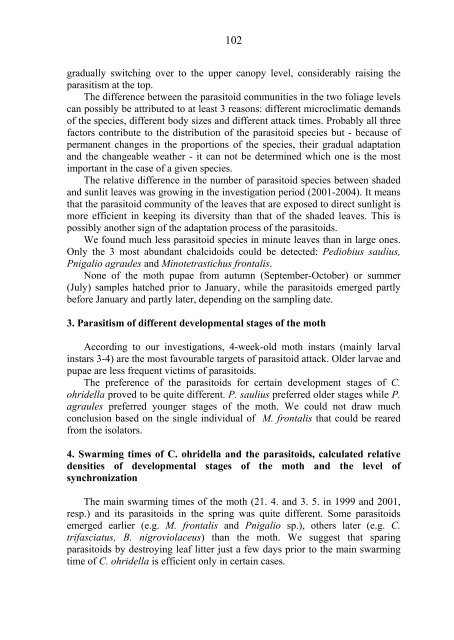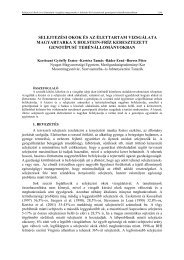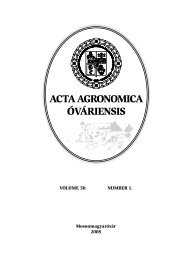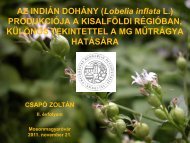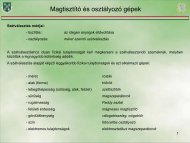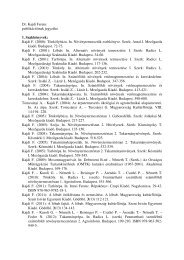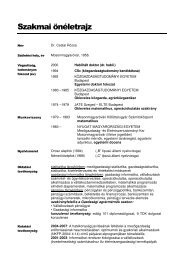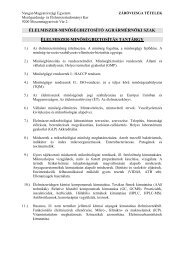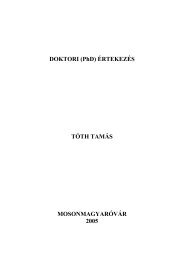DOKTORI (PhD) - Nyugat-Magyarországi Egyetem Mezőgazdaság
DOKTORI (PhD) - Nyugat-Magyarországi Egyetem Mezőgazdaság
DOKTORI (PhD) - Nyugat-Magyarországi Egyetem Mezőgazdaság
You also want an ePaper? Increase the reach of your titles
YUMPU automatically turns print PDFs into web optimized ePapers that Google loves.
102<br />
gradually switching over to the upper canopy level, considerably raising the<br />
parasitism at the top.<br />
The difference between the parasitoid communities in the two foliage levels<br />
can possibly be attributed to at least 3 reasons: different microclimatic demands<br />
of the species, different body sizes and different attack times. Probably all three<br />
factors contribute to the distribution of the parasitoid species but - because of<br />
permanent changes in the proportions of the species, their gradual adaptation<br />
and the changeable weather - it can not be determined which one is the most<br />
important in the case of a given species.<br />
The relative difference in the number of parasitoid species between shaded<br />
and sunlit leaves was growing in the investigation period (2001-2004). It means<br />
that the parasitoid community of the leaves that are exposed to direct sunlight is<br />
more efficient in keeping its diversity than that of the shaded leaves. This is<br />
possibly another sign of the adaptation process of the parasitoids.<br />
We found much less parasitoid species in minute leaves than in large ones.<br />
Only the 3 most abundant chalcidoids could be detected: Pediobius saulius,<br />
Pnigalio agraules and Minotetrastichus frontalis.<br />
None of the moth pupae from autumn (September-October) or summer<br />
(July) samples hatched prior to January, while the parasitoids emerged partly<br />
before January and partly later, depending on the sampling date.<br />
3. Parasitism of different developmental stages of the moth<br />
According to our investigations, 4-week-old moth instars (mainly larval<br />
instars 3-4) are the most favourable targets of parasitoid attack. Older larvae and<br />
pupae are less frequent victims of parasitoids.<br />
The preference of the parasitoids for certain development stages of C.<br />
ohridella proved to be quite different. P. saulius preferred older stages while P.<br />
agraules preferred younger stages of the moth. We could not draw much<br />
conclusion based on the single individual of M. frontalis that could be reared<br />
from the isolators.<br />
4. Swarming times of C. ohridella and the parasitoids, calculated relative<br />
densities of developmental stages of the moth and the level of<br />
synchronization<br />
The main swarming times of the moth (21. 4. and 3. 5. in 1999 and 2001,<br />
resp.) and its parasitoids in the spring was quite different. Some parasitoids<br />
emerged earlier (e.g. M. frontalis and Pnigalio sp.), others later (e.g. C.<br />
trifasciatus, B. nigroviolaceus) than the moth. We suggest that sparing<br />
parasitoids by destroying leaf litter just a few days prior to the main swarming<br />
time of C. ohridella is efficient only in certain cases.


